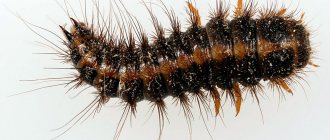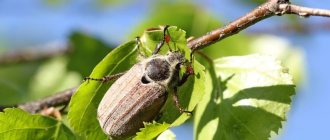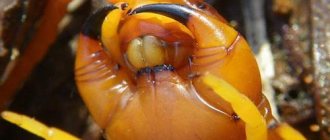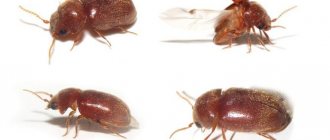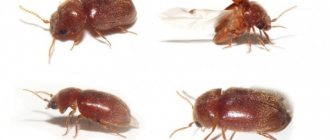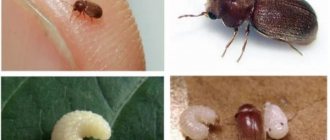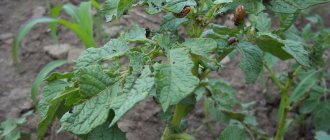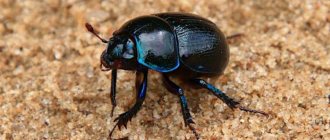Appearance of a bread beetle
Bread beetle (Anisoplia austriaca).
The head shield of bread beetles is extended forward. The jaws are equipped with sharp teeth. Legs are well developed. The tibiae of the hind legs are thickened. The front legs have forked claws, with the help of which the insect is held on to plants.
The body length is about 15-20 centimeters. The color is dark green with a metallic sheen. The elytra are yellow-red, and towards the outer edges they become brown. Often there is a large quadrangular spot on the elytra.
The bread beetle is also called the bread bug.
The back is covered with sparse gray hairs, and the lower part of the body is covered with densely growing white-gray hairs.
Habitat of the bread loaf
These beetles live in Asia and Europe. Bread beetles are most numerous in southern Russia; they are also common in Western Europe, in countries such as Italy and Hungary. They are also found on the Balkan Peninsula. In addition, these pests live in Siberia and Asia Minor.
The harmless name of an insect does not mean it is harmless.
In our country, they are common in Podolsk, Kherson, Ekaterinoslav, Kharkov and other regions, as well as in the Caucasus and Transcaucasia. In the last 20 years, the habitat of bread beetles has spread to the northeast: Vladimir, Saratov, Kazan regions and the like.
Lifestyle
Kuzka is an insect well adapted to drought and high humidity.
Loves sunny weather and is active during the day. With the onset of dusk, it hides among the leaves of plants or under piles of earth. Kuzka feeds on grain crops:
- barley;
- rye;
- wheat;
- wild cereals.
Adults eat ripening, ripe grains, second-generation larvae damage the root system of the plant and live in the ground.
Kuzka bread looks into the distance
The bread beetle is diurnal, hiding in uneven ground at night.
The life cycle of a beetle is approximately 2 years, of which 22 months are occupied by the larval stage. The egg develops in 20-30 days and the pupal phase lasts 13-21 days.
The larvae of the first year of life overwinter, burrowing to a depth of 30-55 cm, of the second year - to 20-45 cm.
After the second wintering, the larva pupates in the second half of May, and in mid-June a mass emergence of beetles occurs.
Kuzka bread on wheatgrass
Lifestyle of a bread beetle
In the south of our country, it usually occurs at the end of May, and in the north - at the beginning of June. At first, it feeds on wild grasses, mainly wheatgrass, and then switches to grain crops: wheat and barley. Rarely eats barley, and completely ignores millet.
The main delicacy for kuzka is grain crops.
They spend the night in cracks in the ground and under rocks. During sleep, bread beetles are completely motionless. Early in the morning, pests climb onto the ears and start feeding. If the weather is cloudy or windy, then the grain loaf does not move, but if it is sunny, it flies from one spikelet to another. They are most active at 2 o'clock in the afternoon, at which time they fly over the field and buzz characteristically. When the heat subsides, the beetles become calmer and begin to intensively eat cereals. By evening, the pests become lethargic and descend to the ground to spend the night.
A beetle eats 6 grains of wheat per day.
Each grain goose eats about 6 grains of wheat per day, and females cause more damage than males. The lifespan of these pests is about a month, so each individual destroys about 180 grains, which is 9 ears. At the same time, they often undereat the grain and start a new one.
Measures to protect crops from beetles
During the period of late spring and early summer, it is necessary to carry out cultivation and treatment of row spacing. Such an event leads to the mass destruction of the pupae of these beetles. Also, at the beginning of wax ripeness, it is necessary to carry out quick separate harvesting, selecting windrows. Such actions also reduce the number of damaged grains. In addition, to prevent the Kuzka grain beetle from crawling out of the ground in the next sowing year, it is necessary to carry out early post-harvest autumn plowing, as well as to peel the stubble. These actions lead to the death of eggs and larvae before they penetrate deeper into the lower layers of the soil.
If the number of beetles exceeds the threshold of harmfulness (more than 3 pieces per 1 square meter), on wheat during the period of milk ripeness it is necessary to organize spraying of the crop with insecticides, EC (l/ha) with sumithion - 0.8 - 1 or extra decis - 0.05. In this case, the last spraying should be carried out no later than 20 days before harvest.
Development of bread beetles
As soon as the beetles emerge from the ground, they begin to mate. Most often this happens on ears of corn. There are approximately 2 times more females than males. After 12 days, the female begins to lay eggs. If conditions are unfavorable, this period may be delayed.
The female buries the clutch in the ground; she lays eggs one at a time or in small portions. This process lasts for 2 days. Having laid one batch of eggs, the female mates again, and then burrows into the ground again and makes a new clutch. This process is repeated several times. Having made the last clutch, it itself, as a rule, dies.
Bread Beetle Eggs: This is how crop destruction begins.
The eggs are white, almost round. They are very delicate, so they do not tolerate moisture and dryness well. The eggs take about 3 weeks to develop, and the larvae hatch in early July.
The larvae are almost white in color, then the head turns red. The body shape is cone-shaped, the head is wide, and the back of the body tapers noticeably. The intestines are visible through the body as a dark stripe. At the end of July, the larva molts for the first time, the second molt takes place the following year in April, and the third in August. The larvae feed on rotting plant debris contained in the soil, as well as plant roots.
In the second year after emerging from the egg, the larva pupates in May. This state lasts almost until the end of June. The larva turns into a pupa in an oval-shaped depression that it makes in the ground itself. The pupae are delicate; they do not tolerate dry or too wet soil.
Young beetles emerge from the pupae. They are soft, their elytra are white. The beetles live in the ground for several days, and when their coloring becomes final, they climb out.
Life cycle
The greatest intensity of beetle flight is observed 2 weeks after the start of summer. At this time, fertilized females begin laying eggs. To do this, they burrow into light, loose soil to a depth of 10-15 cm, and each female lays 30-40 eggs in small piles in 2-3 sessions, after which she dies without leaving the soil. Embryonic development of the eggs lasts for approximately 3 weeks.
The hatched larvae feed on humus and roots of various plants. Having overwintered twice and undergone a series of transformations, they pupate in a specially created cell at a depth of 10-15 cm. After 2-3 weeks, in June - August, young beetles emerge from the ground, which during this period cause great harm in grain fields.
Enemies of the bread loaf
Beetle larvae are destroyed by shrews and beetles. While plowing fields, they are also eaten by birds: gulls, rooks, crows and jackdaws. Adult beetles are hunted by starlings, sparrows, shrikes, beetles, storks and hoopoes.
They are also dangerous from predatory flies and wasps that suck out beetles. Small worms also get into the bodies of the larvae, as a result of which they die.
Malicious activities of the beetle grinder
A bread grinder can ruin almost all products: flour, bread, cereals, crackers, tea, pasta. Does not disdain herbariums and dried herbs, even poisonous ones: belladonna, strychnine, ergot, aconite. If you carefully search, the grinder beetle can be found on bookshelves, where the larvae diligently destroy paper, turning it into fine dusty dust. In the library environment, the insect is called the “book bug” for such pestilence. The kitchen dweller can even get into cigarettes. not interested, so there is no need to worry about wooden floors, walls and furniture.
How to get rid of grinder beetles? Unlike the fast cockroach, darting around the kitchen in search of food, the bread grinder is a permanent insect. Having found a suitable product, the beetle firmly settles in it and begins to actively reproduce. The pest can be identified by the spoiled appearance of perforated products, the presence of dust and excrement in them. Grinder larvae are clearly visible in the breeding area.
Reasons for the mass reproduction of these pests
Previously, these beetles fed on wheatgrass, and then began to move on to cultivated cereal crops. When pests fed on wheatgrass, their numbers were smaller, since after this plant flowered, there was no other suitable food available. When agriculture developed, beetles switched to rye, wheat and barley. Thanks to this, the period of existence of the bread beetle increased. In addition, poor cultivation of the fields affects the proliferation of these pests.
If you find an error, please select a piece of text and press Ctrl+Enter.
The damage caused by the beetle and traditional methods of control
The damage caused by the cutting is hard not to feel. It begins to manifest itself at the larval stage, eating the roots of agricultural crops. The beetle can harm not only wheat, but also oats, barley, rye and other cereal crops. Plants damaged by larvae begin to dry out and die, and the cause of this condition cannot be determined immediately, since the larvae are not visible underground.
Adult individuals are quite voracious and begin to attack grain crops from the very first moments of life, swooping into fields in whole flocks. In a short period of life, one such beetle can eat up to 8 g of grain, but this is already quite significant. But the main damage is caused by beetles not so much by feeding, but by knocking grain from the ears to the ground.
The Kuzka beetle has been known for a long time. Previously, it was simply assembled by hand or knocked down with special ropes, but now folk methods of dealing with kuzka have been improved:
- The beetle loves young grain, so traditional methods often use early harvesting, before hungry beetles have time to damage it.
- The kuzka beetle settles only at the edges of the fields, it is no longer found in the middle, for this reason you can use an excellent distracting maneuver. People sow cheaper crops around the perimeter of the field, which serve as food for the beetles, while the field itself remains untouched.
- As a folk remedy, you can also use a vinegar solution that is used to spray crops.
- Birch ash is also destructive to the beetle. She needs to powder the crops around the perimeter of the field. Unfortunately, this remedy is not very effective against larvae that eat the roots. The powdering procedure is carried out either after rain or in the morning after dew appears, as it is more effective. For 1 hectare of land, 10 kg of ash is used. You can also sprinkle ash on areas of the ground between the rows.

